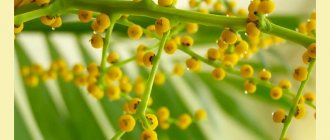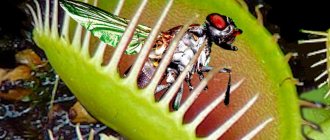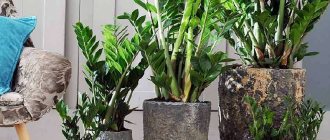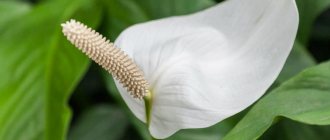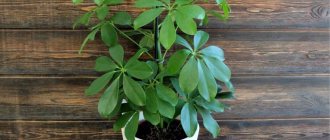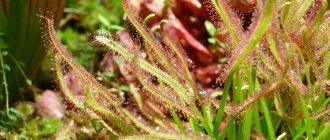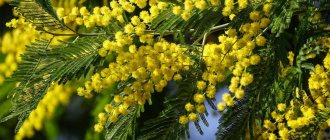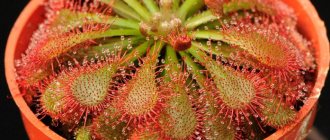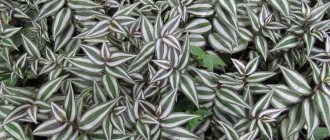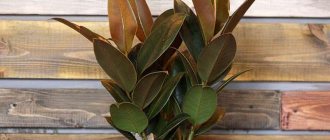Caring for an indoor Hamedorea flower should be special and correct. This is the only way your palm tree will grow beautiful.
House palms are a very popular and popular type of indoor plants. They are distinguished by their unusually beautiful appearance, which is not surprising, because they are exotic. One of the most beloved species of this plant among gardeners is Hamedorea .
It is noteworthy that this is not just a beautiful indoor flower. There are many beliefs and signs associated with this representative of the Palmovs. Therefore, it is not surprising that the interest of lovers of unusual home flora in the plant is growing. Read more below.
Where is the homeland of the domestic flowering Hamedorea palm tree: types, varieties, how it blooms, photos
Hamedorea blooms
Hamedorea is a perennial flowering plant native to the tropics. The flower is widespread in East Africa, Central America, and Madagascar . Also, several varieties of palm grow on the Crimean Peninsula, southern Europe and the Caucasus .
The characteristics of a flower directly depend on its variety. There are many varieties of this home flowering palm tree - indoor Hamedorea. Below you will find photos of some species and see how the plant blooms. The most popular types are:
Hamedorea graceful (elegans)
Hamedorea graceful (elegans):
- It is a perennial single-stemmed plant, growing up to 1.5-2 m in height .
- The trunk has a smooth surface and is covered, as a rule, with 6-7 pinnate leaves .
- Each of them is divided into 8-15 segments of a dark green hue, having a narrow lanceolate shape.
- The inflorescences are panicles, loose in texture, formed by cobs. The latter, in turn, consist of orange-red flowers.
- After the end of the flowering cycle, black berries appear in place of the flowers.
Hamedorea Ernest-August
Hamedorea Ernest-August:
- This type of flower has leaves that are dark green and not divided into segments.
- They look like large and wide plates, sometimes bifurcating at the tips.
- The plant does not have particularly vigorous growth. On the contrary, the pace of its development is slow.
- In general, this type of palm is characterized by a stem form. This means that one rhizome can produce only one stem.
- This culture blooms with red spherical flowers, which are collected in spreading inflorescences.
Hamedorea high
Hamedorea high:
- Already from the name you can roughly understand what the main features of this type of plant are.
- The stems of indoor culture are erect, similar in appearance to bamboo.
- When the leaves at the bottom fall off, and light ring-shaped spots appear instead.
- At the top of the stem there are 4-6 dark green pinnately dissected leaves.
- The narrow-lanceolate lobes are pointed at the edges.
- The plant blooms very beautifully, producing bright orange flowers that form panicles.
Hamedorea unicolor
Hamedorea unicolor:
- This is the most unpretentious type of indoor palm tree among all varieties. That is why it is often the choice of flower growers.
- The shoots of the plant grow slowly and rarely reach more than 100 cm in height.
- The form is characterized as bushy, which is facilitated by the formation of several thin additional shoots.
- At their tops there are leaves of a light green color and pinnately dissected shape.
- Hamedorea unicolor is distinguished by the rapid onset of the flowering period.
Hamedorea metallic
Hamedorea metallic:
- This type of palm tree has leaves that are dark green with a metallic tint. Due to this, this type of flower got its name.
- The leaves of the plant are solid and wide.
- As it develops, the palm trunk thickens and becomes woody.
- A palm tree growing in nature can reach 2 m in height , but in a flower pot where space is limited it will be smaller.
- The culture is characterized by good shade tolerance.
Hamedorea bridble
Hamedorea bridble:
- This representative of exotic indoor plants can grow up to one and a half meters. But it is noteworthy that this palm variety is a hybrid of the popular variety Elegance .
- However, the specimen in question has larger, brighter flowers, and the leaves and shoots are colored emerald.
- Proper care allows the plant to form a lush vegetation mass. It is characterized by an attractive appearance.
Of course, there are many more varieties of Hamedorea . About 120 species of this exotic plant are known But the most popular in home floriculture are the above-mentioned specimens.
Variety of species and varieties
There are about 130 wild species of Hamedorea. There are few indoor plants. They are especially popular for their original feather-like leaves:
- Elegance - grows in the form of a bush, consisting of several small trunks, reaching about 1.5 meters in height. It blooms with many yellow flowers that spread aroma.
- Tall chamedorea is a rich green bush. It begins to bloom three years after it is planted, its buds are orange.
- Hamedorea unicolor is a very common species among domestic palms. A bushy plant consisting of light green leaves on thin stems, up to one meter long. Blooms with faded yellow buds.
- Ernesta Augusta is not a very common species. Consists of a single trunk with broad foliage. Blooms with buds of rich red color.
- Hamedorea bridble (photo) is a relatively recently bred variety, it has a lot in common with elegans, the only difference is in the size and shade of the flowers, they are larger and richer. Caring for the plant at home is required in the same way as for the varieties described above.
Hamedorea: signs and superstitions
There are many signs and superstitions regarding the presence of certain plants in the house. For example, there is a well-known superstition that you should not bring lilacs into your living space, as this promises death to someone close to you. But all this is nothing more than a stupid fiction, in no way confirmed by real facts.
What about the Hamedorea palm? Are there any signs here - good or bad? Of course yes. Here are a few of them:
- Hamedorea is a source of powerful energy, so its presence in a room or office has a beneficial effect on the overall microclimate.
- In the room where the flower grows, people are filled with energy and get rid of the feeling of depression.
- All undertakings and plans will come true for the person caring for the exotic plant.
- The situation in the family is improving, misunderstandings, disagreements and scandals are becoming a rarity.
- Energy vampires try to stay away from people in contact with Hamedorea
- It is contraindicated for selfish individuals to keep such a palm tree next to them, because they may completely lose sensitivity to the feelings of family and friends.
- If there is coziness, tranquility and harmony in the house, then light and lush foliage predominates on the flower. If the branches darken and begin to wither, this indicates the presence of evil spirits and evil energy. By giving away its vital energy, the palm tree tries to cleanse the aura in the house.
Today it is generally accepted that Hamedorea brings only goodness to its owner. Thus, a person who takes care of a flower becomes more self-confident, calm and reasonable. But everything, of course, depends on one more subtlety - vocation. Thus:
- For creative individuals, the palm tree promises recognition, fame and success.
- For businessmen, the flower helps realize commercial plans.
- For athletes who love to care for Hamedorrhea, the indoor plant helps them reach new heights.
However, there is a negative superstition. Our ancestors believed that Hamedorea in the house brings misfortune and trouble. To avoid them, you need to bring the palm tree into the house correctly. Or rather, not bring it in in a pot, but bring it in on wheels, so carts, strollers and other small vehicles were used to transport the plant.
It is up to you personally to believe the signs and superstitions associated with the exotic flower in question. People are now less inclined to follow the warnings that their ancestors trusted.
Hamedorea plant: features of growing at home after purchase
Hamedorea plant
The Hamedorea plant is a flower that requires care. Provide it with optimal growing conditions - and it will please your eyes all year round. Study the features of growing a flower at home after purchase. The intensity of growth and development of culture depends on:
- Temperature indicator in the room
- Air humidity level
- Lighting
- Frequency and abundance of watering
- Substrate composition
- Added fertilisers, fertilizers
- Transplants
Do not forget that the flower needs shading, so place it away from intense light radiation. Also provide the flower with frequent watering. Avoid letting the soil dry out, otherwise the palm tree will simply die.
Briefly about care
- Temperature: 11-19 degrees.
- Flowering: rare, flowers yellow, red or orange
- Air humidity: 50-60%
- Lighting: bright diffused light.
- Where to put it: near the western or eastern window.
- Watering: as the soil dries.
- Soil: for palm trees.
- Feeding: from spring to September, fertilizer for palm trees.
- Replanting: necessary if the roots are sticking out of the drainage holes
- Reproduction: by dividing the bush or by seeds.
Hamedorea flower blooming
The Hamedorea flower begins to bloom in the 3rd year from the moment it is planted in a pot. And if several specimens are placed in one container at once, they will bloom alternately. The yellow flowers have a pleasant scent and their appearance resembles a mimosa.
Important: Experts advise removing flower stalks from young palm trees, since the palm tree spends a lot of vital energy on their formation and development. As a result, its overall growth slows down. If this happens, use fertilizing and fertilizers.
A detailed analysis of caring for chamedorrhea at home
In order to ensure favorable growth for this plant, it is important to provide it with special care in indoor development conditions. Let's consider each nuance in more detail.
Bloom
The main highlight of this type of palm tree is that it begins flowering from the third year. If more than one plant grows in a pot, then over the course of a whole year they will bloom alternately. The yellowish flowers have a pleasant and light aroma, and from a distance they look like a mimosa flower.
Flowers that are just beginning to appear initially resemble leaves, but subsequently begin not only to grow, but also to branch. The buds appear in the form of small balls of a pale green hue, and then begin to turn yellow and become larger.
In room conditions, after about 3 weeks, the garlands of fancy yellowish inflorescences begin to gradually fade, but with proper watering and sufficient feeding, new flowers will soon form. The inflorescences seem to follow each other, decorating the room for a long time.
Temperature regime of the Hamedorea flower when kept at home
It is very important to provide the Hamedorea flower with optimal temperature conditions in the room where it grows. When maintaining a house, the plant reacts very sharply to heat, so in summer the room should be regularly ventilated. This will be enough to ensure that the exotic flower does not die, but fully develops and grows.
As for the cold season, try to maintain the temperature in the room at +12 - +18 degrees . However, do not allow drafts or hypothermia, although the plant survives calmly even in critical conditions.
Spraying the Hamedorea plant
An equally important condition for flower growth is the level of humidity. Its optimal indicator is 50%. When growing a Hamedorea plant in a house or apartment, do not forget to spray it every day. To do this, use settled water or liquid that has previously been passed through a special filter. Ordinary tap water will not work, as it contains many hard impurities that can harm the palm tree.
Some gardeners note that daily spraying is not necessary. It is enough to carry out the procedure twice a week, and in winter even once every 7 days .
Diseases
For successful treatment, it is important to recognize the disease that affects chamedorrhea in time. This is not always easy to do.
Damage to the root system, for example, occurs below the soil surface. But, even in this case, there are certain external signs that will tell the grower about the onset of the disease.
Wilting of shoots
The problem can be recognized by the appearance of brownish spots of rot with white spores . The flower begins to fade.
What to do?
- If measures are not taken in a timely manner, the plant will die. The pot is thrown away along with it or thoroughly washed and disinfected with a solution of potassium permanganate.
- If the lesion is minor, treat twice with a solution of acarin, actellik or other special preparations.
- Maintaining temperature and proper hydration are excellent preventive measures.
Fusarium wilt of shoots
It affects individual shoots, which become faded, gradually wither and die . The disease does not affect the root system. If there is high humidity in the room, the base of the trunk begins to quickly rot and becomes covered with a red coating of spores.
What to do?
- Monitor soil moisture, room humidity and temperature conditions.
- In case of minor damage, treatment with special preparations is required: actellik or phytoferm.
- If the damage is deep, it will not be possible to save the flower. They throw him away. The container can be thoroughly rinsed, doused with boiling water and potassium permanganate.
- It is advisable to carry out work wearing silicone gloves using special tools. After use, they are thrown away or disinfected.
Anthracnose
The leaves are covered with small light spots, which over time change color to brown, the edges become convex with a yellowish border. The spots are located chaotically, merging when the lesion is deep.
What to do?
- Indoors, it is recommended to reduce air humidity, stop spraying leaves, and strictly adhere to the watering regime.
- The palm tree is treated with Rovral.
- Deep damage leads to death. The flower is thrown away and the container is disinfected.
Hamedorea: lighting and watering
Hamedorea
a pot with a Hamedorea near a window facing east. This will be useful for the flower, and also beautiful for the overall interior of the room. The best lighting for this plant is sunlight, but not strong, not scorching, but a little in the morning.
Now about watering:
- In hot months, it is absolutely unacceptable to allow the soil in the pot to become too dry. Therefore, hydration of Hamedorea must be regular and plentiful.
- Water your home palm tree 2-3 times. at 7 days
- It all depends on how hot and dry the weather is. But also avoid overwatering, as it is harmful to the flower.
In winter, it is enough to water the crop only once a week . This will maintain the vitality of Hamedorea and prevent the roots from rotting.
Useful properties of chamedorea
This exotic plant boasts special useful characteristics, for example, activity against phytoncides. Simply put, chamedorea can purify indoor air, in particular from harmful substances - benzene, ammonia, formaldehyde and others that are harmful to human health.
It is also impossible not to note the beautiful appearance of the plant, which can decorate any interior. Most often, a pot with a palm tree is placed in the living room or spacious terrace. This will create the illusion of your own home botanical garden.
Hamedorea can not only fit into the appearance of a room, even with colorful design features, but also calm a person’s emotional state thanks to its rich green color and aesthetic splendor. The flower acquires its full beauty after 4 years.
Pot and soil for indoor Hamedorea flower
Flower growers cannot say unequivocally about which pot to choose for planting Hamedorea. Some botanists believe that a palm flower should initially be planted in a large container. Other connoisseurs of exotic plants in the house note that the pot should be small, so a container with a slightly larger diameter than the previous one, but not too deep, is better suited. But you will still have to replant the palm tree as it grows, so select the container for it at your discretion.
Pay due attention to the composition of the soil for the growth of this plant. Ideally, it should consist of the following components:
- Sand
- Peat
- Special soil (leaf)
Take all components in equal proportions - 1 tsp . Consider the soil pH , which is ideally 5-6.5.
If you are planning to buy a ready-made substrate, then experts advise giving preference to “Palma”. Add a little sand to the soil, mix, put the mixture in a container - and you can start planting Hamedorea.
The soil
For the best soil mixture that meets the requirements of chamedorea, a combination of humus (2 parts), turf soil (1 part), peat (2 parts) and perlite is suitable. Ready-made palm soil or soil for dracaenas will also work. It is worth adding perlite to it for better drainage. For plants of the genus Hamedorea, a lighter soil is recommended than for other palm trees, so a little turf soil is needed for the mixture.
C. metallica
Feeding and fertilizing the houseplant Hamedorea
It is necessary to feed the houseplant Hamedorea during its active flowering phase. That is, the flower needs nutrients most of all in the summer. It is enough to use a universal fertilizer, for example Agricola . It should be used at intervals of 14-28 days. Be sure to dilute the fertilizer with water, since the concentrate is quite strong.
Worth knowing: In cold weather, when the dormant period begins, Hamedorea does not need to be fed.
Providing a nutrient medium (soil, fertilizer, fertilizing)
The soil
Hamedorea is an unpretentious palm tree. It tolerates poorly fertilized soils well and can grow for a long time in small pots without replanting. To grow a healthy palm tree, the roots need to provide a good nutrient environment. To do this, you can independently prepare the soil, consisting in equal measures of:
You can buy Palma soil. It is important that the mixture is light and well permeable to watering and air.
How and when to fertilize and feed
For the first 6 months, freshly transplanted young palm trees are not fertilized. Fertilizers are applied from April to August. Fertilizing with organic matter and fertilizers in the middle and end of the month will be optimal. It is easier to use liquid fertilizer “Palm”, according to the instructions.
During cold periods, well-rooted or long-growing (not transplanted) trees can be lightly fed with fertilizers in highly diluted proportions to maintain soil nutrition. Stimulating growth with short daylight hours during cold periods will lead to the formation of weakened shoots and make the appearance of the palm tree unattractive.
Transplanting a Hamedorea plant
Transplanting the Hamedorea plant
Young specimens of the Hamedorea plant require annual replanting. At the same time, buy a larger pot each time, because the flower is constantly growing and developing. Therefore, it requires more space.
As for adult plants, they need to be replanted when the roots become visible through the hole in the bottom of the container. In such a case, carry out the procedure once every 4-5 years - this will be enough.
Remember: Adult Hamedorea does not tolerate planting well. Therefore, before you begin, remove the top layer of soil and replace it with a new substrate.
Pruning a Hamedorea flower: when is the best time to do it?
Pruning a Hamedorea flower is not a necessary measure if the flower is growing well. When is the best time to do it? If large brown spots begin to appear on the surface of its leaves, then such green mass must be removed. Also, trim leaves back to living, healthy tissue if they turn yellow.
Perform pruning using sharp scissors. Pre-treat them with alcohol - this is a mandatory disinfection measure. Lubricate the cut areas with a fungicidal preparation to prevent infection from joining the “wounds”.
Other Possible Problems
The plant needs not only to be watered, fed and replanted, but also to create certain conditions for its development.
For example, during the dormant period, pruning is required. The lower leaves of the palm tree tend to dry out periodically. The natural process of foliage renewal must be regulated using gardening tools. Yellowed, faded and dried leaves must be trimmed in a timely manner. Sections are treated with any alcohol solution.
Important ! The palm tree not only decorates the space, but also absorbs various toxins.
A strong and hardy chamedorea plant does not require complex care. If you monitor the temperature and lighting in the room, water in moderation, replant and prune in time, the flower will decorate any interior. Wide, voluminous palm leaves will not dry out under normal conditions.
Growing Hamedorea flower from seeds
Growing a Hamedorea flower from seeds
Hamedorea can be bought in a pot at any flower retail outlet. However, many gardeners prefer to grow palm trees from seeds, despite the fact that this is quite painstaking work. If you want to grow an exotic flower from scratch, then remember a few important rules.
Seed selection:
- Choose only the freshest and highest quality grains. Look at each of them carefully. There should be no signs of damage, rot or mold on the surface.
- If you take old grains, there is a risk that most of them will not germinate. Not surprising, since their germination rate decreases by 10% every year.
- For this reason, when purchasing a package of Hamedorea , carefully study the dates.
- The age of planting material should not exceed 10 months .
- If for some reason the date on the bag of seeds is not indicated, refuse to purchase them and look for another option.
Soak:
- Before planting in the soil, Hamedorea should be soaked in clean liquid for 5-6 days .
- Before doing this, lightly file the top layer of grains with a sharpening stone so that they absorb moisture better.
Planting in the soil:
- After soaking, you can proceed to picking the seeds into the prepared soil.
- Place the grains with the sawn parts down in separate cups intended for germinating seedlings.
- There is no need to sprinkle the planting material with soil; place the container with it in a greenhouse, as it is important to provide it with a greenhouse effect.
Do not forget to regularly ventilate and moisten the soil. You will see the first shoots in about 2 months. , if you sowed homemade seeds. When picking purchased grains, seedlings will appear within 6-8 months . When the leaf reaches a size of 4 cm , the grown sprouts can be moved to a permanent container.
How to propagate chamedorea
There are three ways to propagate a plant:
- Seeds,
- By dividing the bush,
- Radical shoots.
Growing by seeds
The peculiarity of the propagation of chamedorea by seeds is the long period of germination of seedlings, sometimes up to 6 months. To ensure good germination, when buying chamedorea seeds in a store, pay attention to the packaging date. They cannot be stored for long periods of time, which is why their germination rate decreases by about 10% every month.
1. Pre-soak the seeds for 5 days.
2. After 5 days, you need to carefully destroy the upper hard shell. This is done with a triangular small file. This operation accelerates the germination of seedlings.
3. Make drainage holes in disposable cups and pour the substrate 15 mm below the edge. The seeds are placed with the sawn part into the ground with light pressure. They are not covered with soil.
4. The top of the cup is covered with transparent polyethylene, ensuring 100% humidity.
Reproduction by dividing the bush
If a lot of seeds were sown in a pot, then when they grow, they form a kind of palm bush. Reproduction by this method is carried out in May. To do this, the earthen lump is carefully destroyed. Plants are separated and planted in a substrate.
Reproduction by root shoots
Hamedorea reproduces well vegetatively - by basal shoots from the mother plant. The offspring are separated after they have formed roots. And then they are planted in a prepared container with soil.
Reproduction of Hamedorea by division
Reproduction of Hamedorea by division
You can also grow Hamedorea by division. This propagation option is good in the case when you already have a blooming palm flower in your apartment, but you want to have a few more specimens for yourself or for sale. How does this happen? More details:
- Perform the procedure in the spring months - from mid-March, April, May.
- Remove the palm bush from the container and lightly wash the earthen lump under a tap with running water.
- Divide the bush into several elements so that each of them retains a healthy, fully formed shoot (cutting) and developed roots.
- Place the resulting parts of the palm bush in different pots.
It is worth noting that flowers, when propagated by division, will need about a month to adapt, after which they will begin to actively grow.
Leaf tips dry out due to water quality
Tap water is not suitable for watering indoor plants.
Water for irrigation should not contain alkali, acids or toxic compounds. Tap water can burn the root system of some plants, such as spathiphyllum, chlorophytum. It is categorically not recommended to water them with water taken from the city water supply.
For them, you can use melt water, rain water or settled water. Even purifying tap water with activated carbon tablets will not bring the desired result. When interacting with sorbents, fluorine and chlorine disappear, but the sorbent cannot remove impurities of calcium and salts. A compromise solution for watering indoor plants is distilled water.
Hamedorea plant - diseases and pests: why do the leaves dry out?
Hamedorea plant - leaves dry out.
Hamedorea acquires strong immunity and can withstand various phytopathologies. However, it will still not be possible to completely insure it against diseases, so you need to at least know what ailments the flower most often suffers from, or what external factors negatively affected it. What diseases and pests exist in the Hamedorea ? Why do the leaves dry out?
- If the ends of the leaves dry out , this indicates increased dryness of the air in the apartment. Ventilate the room more often and spray the palm tree.
- Yellowing of leaves occurs due to excess lighting or the use of hard, insufficiently filtered watering liquid. To improve the situation, move the flower to a darker room, and also use softened water for watering.
- Rotting, drooping or dying of leaves indicates rotting of the root system of the domestic palm tree. This usually happens in winter and is a consequence of overwatering the plant. To prevent Hamedorea from dying, water it less often in cold weather, and also do not forget to loosen the soil. If the situation reaches a critical point, you will have to transplant the flower into a new pot. Before doing this, do not forget to remove areas of rotten roots. Add drainage and water-retaining components - coal or sphagnum - to fresh soil.
- Brown spots on the leaves are another sign that the palm tree is overwatered or is using hard water to treat it. Trim damaged areas of green mass, reduce watering and henceforth use only softened and filtered water.
- Wilting and darkening of the leaves is observed when the bush is kept in low temperature conditions. Move the container with the green plant to a warmer room - and the situation will improve.
- The falling of the lower leaves is considered a normal process when the green mass begins to “age”. Such leaves must be cut off, and then treated with a fungicide at the cut points.
- Sometimes a cotton-like coating appears on the leaves of Hamedorea . It signals that the flower has been affected by a mealybug. Insecticides are used to eliminate phytopathology.
- This exotic flower is often attacked by spider mites and scale insects. To get rid of pests, treat the leaves with a special compound that can be bought at any flower shop.
Hamedorea is a plant that truly pleases with its greenery and adds positivity to life. It is distinguished by lush, amazing flowering, but it needs care and attention. But if you provide the flower with the proper growing conditions, it will not bring you much trouble, but will become a wonderful decoration for the interior of your home. Good luck!
Do you have Hamedorea growing at home? How do you look after her?
Pests
The bamboo palm often suffers from insect pests. If the air in your home or office is too dry, it can cause spider mites to appear. When affected, the shoots and leaves are entangled in a web, which is easy to see upon visual inspection.
The plant's unstable immunity attracts scale insects, thrips and aphids. Small insects feed on the sap of shoots and leaves, which subsequently causes chamedorea diseases. Pests can be gotten rid of by treating with a soap solution, as well as using special fungicidal preparations.
Additional Information! Harmful insects can cause chamedorea leaves to turn yellow. If the uninvited guests are destroyed and the affected leaves are pruned in a timely manner, the palm tree will restore its health.
